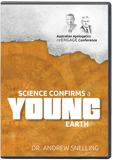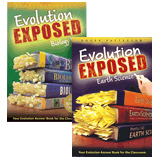Noting News: How to Interpret Science News
More than ever, it seems newspapers and magazines are filled with reports that “confirm” evolution, extol Charles Darwin, and make a mockery of the Bible. For example, one recent news report declared, “Researchers say proof of this transitional species finally confirms Charles Darwin’s theory of evolution.” What are Christians supposed to think amid the onslaught of science reports that seem to contradict the Bible?
News to Note
Each Saturday for the past three years, Answers in Genesis has published News to Note, a review of science and other news interpreted from a biblical, young-earth creation perspective. Visit www.answersingenesis.org/news-to-note to read the latest, and come back each Saturday to both a review of relevant news and our answer to stories that seem to dispute the Bible.
In order to understand and take good note of the news, Christians must learn to think critically, deconstructing the news we read and watch and submitting it to biblical analysis. We must understand the presuppositions embedded in headlines, reports, and journalists and determine what we’re really looking at.
The outline of principles below will help you remember what questions to ask when encountering a news report that originates from an anti-biblical worldview. This valuable skill will become second nature as you train yourself by repeatedly analyzing the news according to these principles. There’s no need to worry that a news report someday will “disprove” the Bible!
1. Dig Beneath the Surface
- Is the headline accurate? Since headlines are the first thing most people see, it’s no surprise that editors write headlines to grab your attention. But headlines sometimes sensationalize the story, oversimplifying the complex and presenting only one side (usually the more controversial) of a debate.
- What am I reading? Not all “articles” are created equally. The degree of subjectivity will likely be much higher in a blog entry, an opinion column, an editorial, or a press release. And while well-written, well-researched, objective articles do exist, it’s a dangerous mistake to assume every article is “fair and balanced.”
- Who is behind the news? Sometimes, the author of an article and the news organization that published it reveal a lot about bias, too. Many news sources have either hidden or intentional biases (such as partisan newspapers). Even subconscious and unintentional bias can play a role, such as when a journalist decides who to speak with to get “both” sides of a usually many-sided story.
2. Get Down to the Real Story
- What are the “hard” facts? It’s best to begin by determining the actual facts behind the headline. What fossil was found? What experiment was performed? What (raw) data were measured? Too often these important details from the original scientific paper are absent in news summaries and science reports, obscured or even replaced by lofty conclusions based on one scientist’s worldview or the biases of the reporter (who may not be knowledgeable about the field in question).
- What are the basic interpretations? After the facts are in, scientists must begin to infer and induce conclusions based on various assumptions. Often these inferences are based on reasonable assumptions, but every now and then scientists will (usually unwittingly) take a leap in logic from the get-go because of their predetermined biases and expected conclusions.
- What are the assumptions behind the headlines? On top of the basic interpretations, scientists will generate a broader interpretation—a grand conclusion—based on their worldview. But these headline-grabbing pronouncements are frequently built on numerous assumptions and sometimes reflect more on the beliefs of the scientist (or reporter or editor) than on the actual discovery.
3. Determine the Significance
- What is left after un-spinning the story? After sorting through sensational headlines and assumption-riddled speculations, the question is how the find fits into the creation model. A ready awareness of up-to-date creation research and ideas in fields like geology, paleontology, biology, anthropology, and astronomy is important.
- Does this change the game? Occasionally there really is something new about a scientific find, even beyond the spin—it isn’t just more of the same. Sometimes aspects of creation models even need to change. Don’t forget that although God’s Word is inerrant, creation models themselves can be wrong; we are constantly trying to develop the most accurate creation models possible.
- What does God say? It may take innovative thinking to understand how a discovery fits with creation models. That’s why we must remember that God laughs at what may look to us, temporarily, as a “contradiction” between the Bible and science. Don’t lose faith today for what will be explained tomorrow—sometimes even as a hoax, such as Piltdown Man. Remember that, “By definition, no apparent, perceived, or claimed evidence in any field . . . can be valid if it contradicts the Scriptural record . . . evidence is always subject to interpretation by fallible people who do not possess all information” (AiG Statement of Faith).
For more information:
Recommended Resources

Answers in Genesis is an apologetics ministry, dedicated to helping Christians defend their faith and proclaim the good news of Jesus Christ.
- Customer Service 800.778.3390
- Available Monday–Friday | 9 AM–5 PM ET
- © 2025 Answers in Genesis




